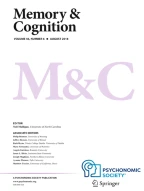Abstract
When researchers are interested in the influence of long-term knowledge on performance, printed word frequency is typically the variable of choice. Despite this preference, we know little about what frequency norms measure. They ostensibly index how often and how recently words are experienced, but words appear in context, so frequency potentially reflects an influence of connections with other words. This paper presents the results of a large free association study as well as the results of experiments designed to evaluate the hypothesis that common words have stronger connectionsto other words. The norms indicate that common words tend to be more concrete but they do not appear to have more associates, stronger associates, or more connections among their associates. Two extralist cued recall experiments showed that, with other attributes being equal, high- and low-frequency words were equally effective as test cues. These results suggest that frequency does not achieve its effects because of stronger or greater numbers of connectionsto other words, as implied in SAM. Other results indicated that common words have more connectionsfrom other words, including their associates, and that free association provides a valid index of associative strength.
Article PDF
Similar content being viewed by others
Avoid common mistakes on your manuscript.
References
Anderson, J. R., &Bower, G. H. (1974). A propositional theory of recognition memory.Memory & Cognition,2, 406–412.
Bahrick, H. P. (1970). Two-phase model for prompted recall.Psychological Review,77, 215–222.
Canas, J. J. (1990). Associative strength effects in the lexical decision task.Quarterly Journal of Experimental Psychology: Human Experimental Psychology,42, 121–145.
Cofer, C. N., &Shevitz, R. (1952). Word association as a function of word frequency.American Journal of Psychology,65, 75–79.
Cramer, P. (1968).Word association. New York: Academic Press.
Dennis, S. (1995). The Sydney Morning Herald Word Database.Noetica: Open Forum,1(4).
Dennis, S., & Humphreys, M. S. (2000).The role of context in episodic recognition: The bind cue decide model of episodic memory. Manuscript submitted for publication.
Gillund, G., &Shiffrin, R. M. (1984). A retrieval model for both recognition and recall.Psychological Review,91, 1–67.
Gregg, V. (1976). Word frequency, recognition and recall. In J. Brown (Ed.),Recall and recognition (pp. 183–216). London: Wiley.
Hayes, J. R., &Flower, L. S. (1986). Writing research and the writer.American Psychologist,41, 1106–1113.
Hollingworth, H. C. (1913). Characteristic differences between recall and recognition.American Journal of Psychology,24, 533–544.
Howes, D. A. (1957). On the relation between the probability of a word as an association and in general linguistic usage.Journal of Abnormal & Social Psychology,54, 75–85.
Johnson, D. M. (1956). Word association and word frequency.American Journal of Psychology,69, 125–126.
Kŭcera, H., &Francis, W. N. (1967).Computational analysis of present-day American English. Providence, RI: Brown University Press.
Nelson, D. L., Bennett, D. J., Gee, N. R., Schreiber, T. A., &McKinney, V. M. (1993). Implicit memory: Effects of network size and interconnectivity on cued recall.Journal of Experimental Psychology: Learning, Memory, & Cognition,19, 747–764.
Nelson, D. L., Bennett, D. J., &Leibert, T. W. (1997). One step is not enough: Making better use of association norms to predict cued recall.Memory & Cognition,25, 785–796.
Nelson, D. L., &McEvoy, C. L. (1979). Encoding context and set size.Journal of Experimental Psychology: Human Learning & Memory,5, 292–314.
Nelson, D. L., McEvoy, C. L., & Schreiber, T. A. (1998). The University of South Florida word association, rhyme, and word fragment norms. Available http://www.usf.edu/FreeAssociation/
Nelson, D. L., McKinney, V. M., Gee, N. R., &Janczura, G. A. (1998). Interpreting the influence of implicitly activated memories on recall and recognition.Psychological Review,105, 299–324.
Nelson, D. L., &Schreiber, T. A. (1992). Word concreteness and word structure as independent determinants of recall.Journal of Memory & Language,31, 237–260.
Nelson, D. L., Schreiber, T. A., &McEvoy, C. L. (1992). Processing implicit and explicit representations.Psychological Review,99, 322–348.
Nelson, D. L., &Xu, J. (1995). Effects of implicit memory on explicit recall: Set size and word frequency effects.Psychological Research,57, 203–214.
Noble, C. E. (1952). An analysis of meaning.Psychological Review,59, 421–430.
Paivio, A., Yuille, J. C., &Madigan, S. (1968). Concreteness, imagery, and meaningfulness values for 925 nouns.Journal of Experimental Psychology Monograph Supplement,76 (1, Pt. 2), 1–25.
Postman, L. (1970). The California norms: Association as a function of word frequency. In L. Postman & G. Keppel (Eds.),Norms of word association (pp. 241–320). New York: Academic Press.
Roediger, H. L., III (1974). Inhibiting effects of recall.Memory & Cognition,2, 261–269.
Rubin, D. C., &Friendly, M. (1986). Predicting which words get recalled: Measures of free recall, availability, and pronunciability for 925 nouns.Memory & Cognition,14, 79–94.
Saltz, E. (1967). Thorndike-Lorge frequency and m of stimuli as separate factors in paired-associate learning.Journal of Experimental Psychology,73, 473–478.
Schreiber, T. A. (1993).ListChecker [Unpublished computer program].
Shiffrin, R. M., &Steyvers, M. (1997). A model for recognition memory: REM—retrieving effectively from memory.Psychonomic Bulletin & Review,4, 145–166.
Spreen, O., &Schulz, R.W. (1966). Parameters of abstraction, meaningfulness, and pronounceability for 329 nouns.Journal of Verbal Learning & Verbal Behavior,5, 459–468.
Thorndike, E. L., &Lorge, I. (1944).The teacher’s word book of 30,000 words. New York: Columbia University, Teachers College Press.
Toglia, M. P., &Battig, W. F. (1978).Handbook of semantic word norms. Hillsdale, NJ: Erlbaum.
Tulving, E. (1976). Ecphoric processes in recall and recognition. In J. Brown (Ed.),Recall and recognition (pp. 37–73). London: Wiley.
Underwood, B. J., &Schulz, R.W. (1960).Meaningfulness and verbal learning. Chicago: J. B. Lippincott.
van Dijk, T. A., &Kintsch, W. (1983).Strategies of discourse comprehension. New York: Academic Press.
Winnick, W. A., &Kressel, K. (1965). Tachistoscopic recognition thresholds, paired-associate learning and immediate recall as a function of abstractness-concreteness and frequency.Journal of Experimental Psychology,70, 163–168.
Author information
Authors and Affiliations
Corresponding author
Additional information
This research was supported by Grant MH16360 from the National Institute of Mental Health to D.L.N. and Grant AG13973 from the National Institute on Aging to C.L.M.
Rights and permissions
About this article
Cite this article
Nelson, D.L., McEvoy, C.L. What is this thing called frequency?. Mem Cogn 28, 509–522 (2000). https://doi.org/10.3758/BF03201241
Received:
Accepted:
Issue Date:
DOI: https://doi.org/10.3758/BF03201241
